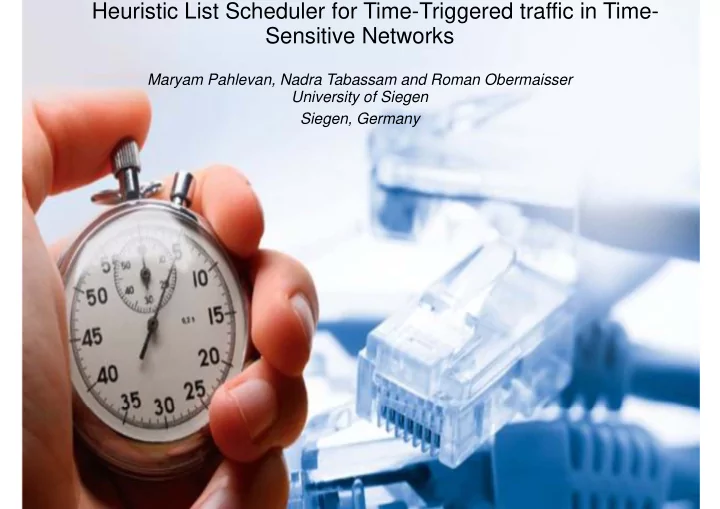

Heuristic List Scheduler for Time-Triggered traffic in Time- Sensitive Networks Maryam Pahlevan, Nadra Tabassam and Roman Obermaisser University of Siegen Siegen, Germany
Background- Time Sensitive Networking Standard Ethernet Provides high bandwidth and seamless connectivity But does not offer temporal properties Time Sensitive Networking (TSN) Offers deterministic behavior with several Ethernet extensions Introduces new shaping mechanism (Time Aware Shaper) Uses fault tolerant synchronization mechanism (IEEE 802.1ASrev) 7/10/2018 Heuristic List Scheduler 2
Time-Triggered Traffic Scheduling Requires knowledge of Network topology TT traffic specification Is NP- complete Offline Simplify using several abstractions Majority of TT schedulers Fixed routing Employ scheduling constraints 7/10/2018 Heuristic List Scheduler 3
Motivation and Contribution Heuristic List Scheduler for TSN scheduling problem Joint scheduling and routing constraints Inter-flow dependency Distributed real time application Optimize TT communication overhead and makespan Scalable to large time sensitive systems 7/10/2018 Heuristic List Scheduler 4
Related Works TT scheduler with fixed routing GCL synthesize using ILP approach (Pop et.al) Define scheduling constraints for TAS and compute GCL using SMT and OMT (Craciunas et.al) TT scheduler with joint routing and scheduling constraints ILP based solution and evaluation of network and load dependency (Schweissguth et.al) Introduce Pseudo-Boolean (PB) variables and employ optimization algorithm (Smirnonv et.al) Aforementioned solutions are slow and not support application specific period 7/10/2018 Heuristic List Scheduler 5
System Model Application graph : G P (T C , F TT ) T C : computational tasks F TT : TT flows Architecture graph : G A (R C , L d ) R C : end systems and switches L d : physical links 7/10/2018 Heuristic List Scheduler 6
Problem Formulation Compute transmission schedule for TT traffic AVB and BE traffic sent when no TT frame scheduled Each computational task identified by t.ST : task start time t.ET : task execution time Each TT flow identified by f.IT : when execution of parent task is completed and transmission of flow starts f n (size) : the number of TT frames multiplied by frame length f d : maximum admissible end to end latency f.e2eD: actual end to end delay for flow delivery f p : periodicity of flow 7/10/2018 Heuristic List Scheduler 7
Problem Formulation Cont.. A TT frame remains in TSN capable device f PT = PR ( device ) f n All GCL of devices start at same time Port specific GCL repeated over hyper period 7/10/2018 Heuristic List Scheduler 8
Scheduling and Routing Constraints Resource Allocation Constraint Each task assign to only one end system Path-Dependent Constraint f r comprised of all adjacent links between sender and Contention-free Constraint An exclusive access to all links of f r for duration of f PT + f.TD Application Specific Periodicity Constraint Each TT flow can be sent over different cycles • Each TT flow is scheduled on a certain link considering other TT flows access same link • periodically Inter-Flow Dependency Constraint Each task can start transmitting TT frames only after arrival of all incoming flows • Delivery Deadline Constraint Each TT flow must delivered to the successor task within f d • 7/10/2018 Heuristic List Scheduler 9
Heuristic List Scheduler (HLS) Calculate priority of each task using critical path concept Sort Tasks based on their priorities For each task If Task has incoming flows, first schedule all predecessor tasks If Task has no child or all predecessor tasks are scheduled, assign available end system to receiver task Find all routes between sender and receiver end systems For each route, find the earliest injection time Considering contention-free and application specific periodicity constraints Considering routes for all incoming flows, choose the receiver 7/10/2018 Heuristic List Scheduler 10 List scheduler (LS) follow same procedure considering only shortest path
Example of TT Schedule by HLS and LS 7/10/2018 Heuristic List Scheduler 11
Experimental Set up Network topology Ring as a typical industrial structure Meshed to provide higher routing possibilities All links are 1Gbps Application graph 20 computational tasks 3 traffic class 7/10/2018 Heuristic List Scheduler 12
Experimental Results Traffic load dependency Makespan: HSL improves makespan 28% compared to LS Scheduling capability: schedulability ratio of LS is 0.32 while HSL schedulability ratio is 0.94 Execution time: LS is faster than HLS 7/10/2018 Heuristic List Scheduler 13
Experimental Results Cont.. Network dependency Scheduling capability: schedulability ratio of LS and HLS degraded significantly compared to meshed topology 7/10/2018 Heuristic List Scheduler 14
Conclusion HLS outperforms LS in various traffic loads and network topologies HLS meets its goal to find TT schedule with optimal makespan HLS support inter-flow dependencies and distributed real time application 7/10/2018 Heuristic List Scheduler 15
Thank You Any Question? Maryam Pahlevan, University of Siegen <maryam.pahlevan@uni-siegen.de> Nadra Tabassam, University of Siegen <nadra.tabassam@uni-siegen.de> Prof. Roman Obermaisser, University of Siegen <roman.obermaisser@uni-siegen.de> 7/10/2018 Heuristic List Scheduler 16
Recommend
More recommend